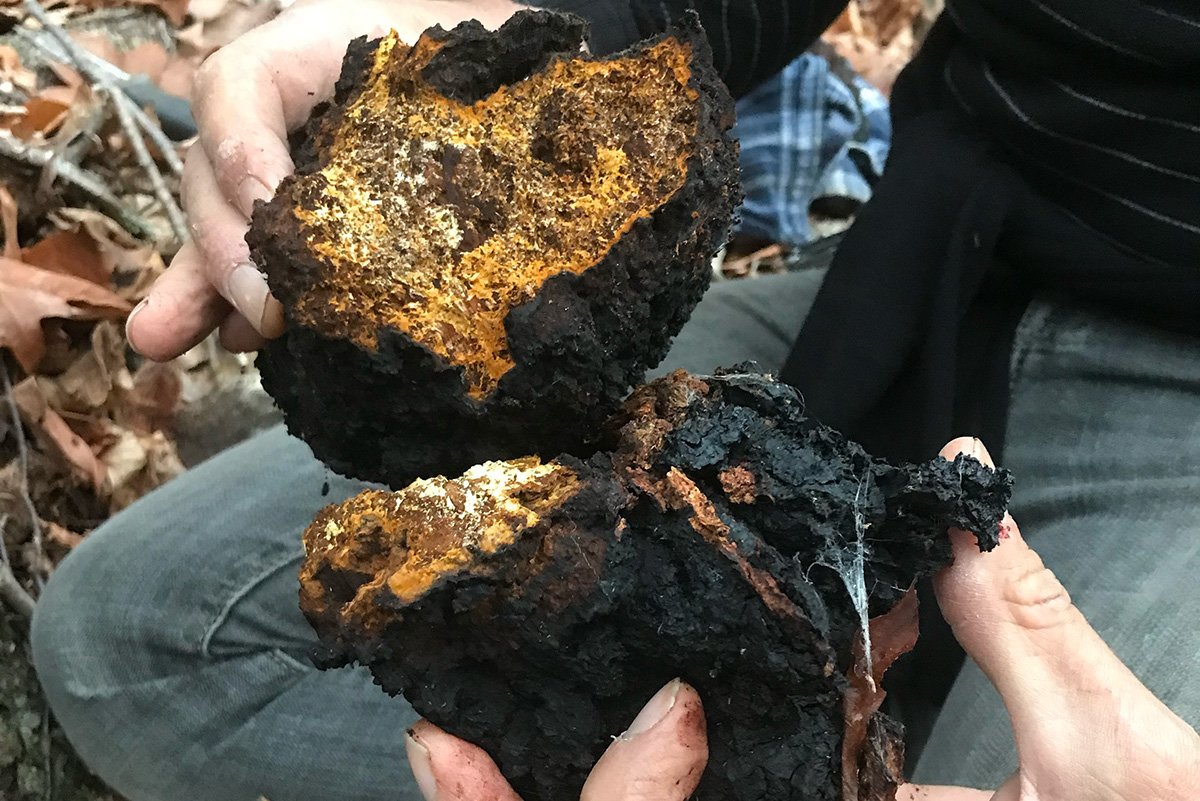Chaga Mushroom Benefits, Habitat & Medicinal Preparations
Chaga Habitat, Anatomy & Lifecycle
Chaga is a medicinal mushroom that grows here in the southern Appalachians. Typically it grows at 3,500 feet in elevation or more. Every so often, you can find it at lower elevations in the Southern Appalachians whenever those elevations are in deep coves or on the north side of mountains. Chaga mushroom needs cooler climates to grow. We anticipate that with climate change we are going to see changes in the fungi's range. It may start growing in areas that it currently does not inhabit and it may disappear from areas where it currently grows.
Chaga is mainly found on birch trees. Yellow birch, black birch and further north in latitude, you will find it on white birch as well, because the climate is cooler. Chaga can sometimes be found growing on trees other than birch (we have personally found it on white oak), but if chaga is not grown on birch trees, then it is not medicinal. This is due to the betulinic acid found in birch trees that the chaga uptakes (more about this later).
Something to note is that if you find chaga on a dead birch tree, then the chaga itself is also dead. The chaga mushroom is a parasite on the birch trees, and it continuously tries to kill the birch tree so that it can then produce a true fruiting body and distribute its spores. The part of the mushroom that you actually use is not what we would consider a fruiting body. It is called a sclerotia. It is essentially a hardened mass of mycelium and an energy reserve. If the tree dies with the chaga sclerotia on it then the sclerotia has a very short life because the energy is then taken from the chaga to create a fruitbody.
The fruitbody of chaga isn't something most people have seen. It appears often under the dead birch tree's bark. It is a polypore's hymenium (spore producing surface). It just looks like a crust or skin of pores. Nothing fancy but clearly effective! This is where all of the chaga's energy goes, to the next generation of spores to be picked up by insects and cast on the wind.
This relationship between chaga and birch is an age-old battle that has been going on for who knows how long. We have seen trees in the forest here that have a small pile of chaga near the base and the wound has completely healed over. Sometimes the chaga wins and sometimes the tree wins.
During this dance between the birch tree and the fungi, the chaga mycelium will take the tree’s nutrients and sugars and create complex medicinal compounds that are beneficial to humans. It takes the simple sugars from the trees and creates polysaccharides, and will also hyper-accumulate other compounds such as betulinic acid that get stored in the sclerotia (the part of the chaga we use).
Chaga Benefits
Chaga is considered the king of medicinal mushrooms. So far we have found it contains over 200 medicinal compounds with an array of complex polysaccharides. It makes it one of the most potent medicinal mushrooms on the planet. Reported chaga benefits include being antiviral, anti-inflammatory, anticancer and more.
As mentioned earlier, the betulinic acid found in birch trees is one of the major compounds that makes chaga medicinal. The betulin found in chaga is antiviral and contains triterpenes. Betulinic acid itself is a pentacyclic triterpenoid, which is a class of chemical compounds known for their anti-inflammatory and anticancer properties.
Betulinic acid also induces apoptosis in tumors; a Polish study released in 1997 suggested that since betulinic acid has a lower pH, it has effects on the mitochondria of tumor cells which lead to apoptosis. Betulinic acid is also effective against single cell parasites.
Syringic acid is another compound found in chaga mushroom; it’s a byproduct of lignin degradation (a process wherein the fungi breaks down lignin in its host wood) and is antibacterial. A study in 2018 that suggests syringic acid could be used as a treatment for preventing skin cancers due to UV radiation.
How to Make Medicine with Chaga
The way that we extract chaga for our purposes is a water decoction, which means a low simmer for at least one and a half to two hours. This type of extraction needs to be used pretty quickly, or it can be frozen to extend shelf life.
You can also make a double extraction with chaga, which is shelf-stable. A double extraction is a process that combines an alcohol extraction with a water extraction to create an extract that has more medicinal constituents than alcohol or water alone would provide. First you extract the chaga in alcohol for eight weeks, then press the alcohol off of the mushroom flesh. Then you do a hot water extraction with the same plant material for 1.5 to 2 hours at a low simmer. Combine the alcohol extract and the water extract and voila! You have a double extraction of chaga. The alcohol pulls enzymes and low molecular weight compounds out and the hot water extraction breaks the chitin in the cell walls and helps liberate the heavier weight polysaccharides. This provides a shelf stable product that will last for at least one year.
Another way we love to consume chaga is by making chaga chai. We use all of our chai herbs and place those into a slow cooker with ground chaga, and then keep that on low for anywhere from four to eight hours. Afterwards we just drink the chai! It’s a fantastic way to get the medicinal benefits of chaga without feeling like you’re taking medicine- you’re just drinking chai! It has a pretty pleasant taste. Some people find that it has a slight vanilla flavor if you just drink chaga tea on its own, but I definitely enjoy using it in conjunction with chai herbs.
When you start taking chaga, be careful to not overdo it. Chaga chelates heavy metals, which is advantageous for us because it allows the heavy metals to be moved out of our bodies. Chela means "claw", and chelation is basically the process of binding like a cage or claw around those metals. However, when heavy metals are chelated, they cannot be deposited back into your body. So if they can't be pushed out of your lymphatic system fast enough, they will just bounce around in your bloodstream until they can be moved out.
This is why it’s best to take it slow when starting to consume chaga- to give your body time to properly remove the heavy metals from your system. If your body can’t remove them quickly enough, you may get a headache and feel tired or even catatonic. Even if it’s just been an extended period of time since you’ve taken chaga, go slowly and be gentle with yourself.
Chaga is a fantastic medicinal mushroom with strong immune-boosting and heavy-metal-chelating properties. To learn more about chaga (and six other medicinal mushrooms), download our free ebook:




